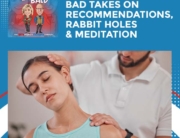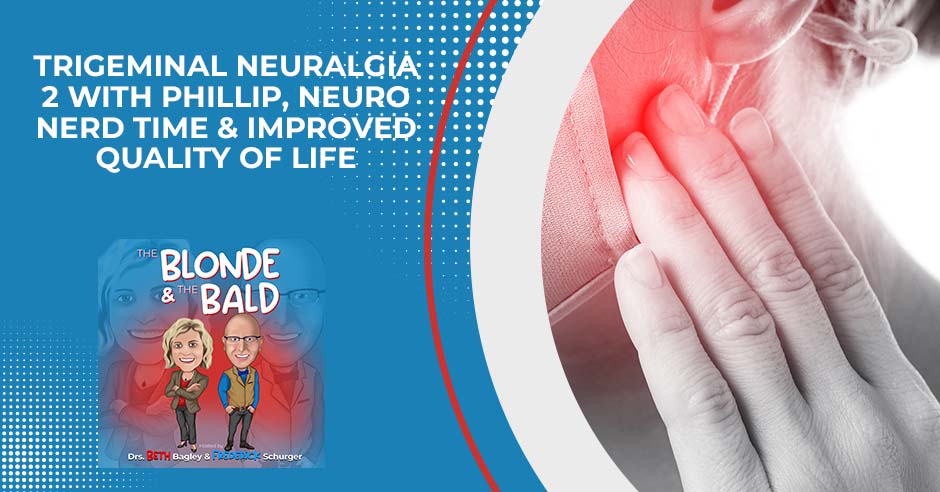
Dr. Bagley’s patient experiences periodic headaches thinking it is normal. It was not! Phillip shares his harrowing story about recovering from Trigeminal Neuralgia. Then Dr. Schurger goes full-on nerd on the trigeminal nucleus, with Dr. Bagley reigning him in. Then they wrap up by sharing about a couple of patients who improved their quality of life from care. Tune in to this episode now!
https://linktr.ee/theblondeandthebald
—
Watch the episode here
Listen to the podcast here
Trigeminal Neuralgia 2 With Phillip, Neuro Nerd Time & Improved Quality Of Life
In this episode, we got a special guest with us. His name is Philip. He is one of my patients that I love and care about so much. He said he would share his story or pieces of his story with us. I’m excited to hear about it. I’m going to start by asking him some questions. Is that all right, Doctor?
It sounds good. Let’s go for it.
Philip, you started chiropractic care quite a long time ago but you are dealing with something called trigeminal neuralgia and some other things that happened to you. Upper cervical has been an integral part of helping keep you out of the hospital, which is awesome. Tell us your story of how things began and how you arrived at where you are.
After nearly twenty years in construction and heavy equipment, that may not be 100% of the culvert but that was a lot of heavy equipment rides, rough and 2 or 3 car wrecks being rear-ended the whiplash and 3 other circumstances that could have brought it on the whole combination. One day I woke up with a headache. I would get periodic headaches. We thought they were normal but they weren’t.
What brought attention was when I woke up in such pain. I could not physically lie down for over 40 days. I could not physically lay down in any position, not even on my stomach. It was severe. My wife even thought I might be going into shock. When I would sleep, I would have to sleep sitting up, propped up in a corner from exhaustion.
My dear 84-year-old mother took me to a doctor that did upper cervical care that she had heard about in Springfield, Missouri, which is where we were based. Slowly, I started getting better. I will back up a little bit. I was to the point that the trigeminal neuralgia would come and go on top of the pain that was stopping me from lying down. It would increase dramatically. I could not lie down. I was ready to have all my teeth pulled. The oral surgeon called my primary. He thought I had trigeminal neuralgia. There is a sports medicine doctor. I went to him also. He verified it along with a couple of other doctors. With that trouble, I went to several different doctors of different care specialties.
Dr. Curtis Horgen in Springfield was the man that got me started on this. It took several years. The trigeminal neuralgia would last about 40 minutes. There were no short verses, nearly times 40 minutes of it. They checked me for a stroke because the pain was severe. I started coming up here to visit grandchildren. Dr. Fortune notified Dr. Bagley, who is my permanent doctor.
I’m much better. There are no more hospital visits. The trigeminal neurology, I have not had a true one in several months. I have not had what I was going through at that time. Sometimes I will get a little pain, which may be coming but it doesn’t. Evidently, the trouble that I had with C1 and C2 was severe. I could have had surgery. However, I was not a big believer in that. They said, “It was challenging.” To me, “That sounds dangerous.” I also did not want to wake up with a permanent headache like what I had before. This care has given me my life back and I can visit with my grandkids.
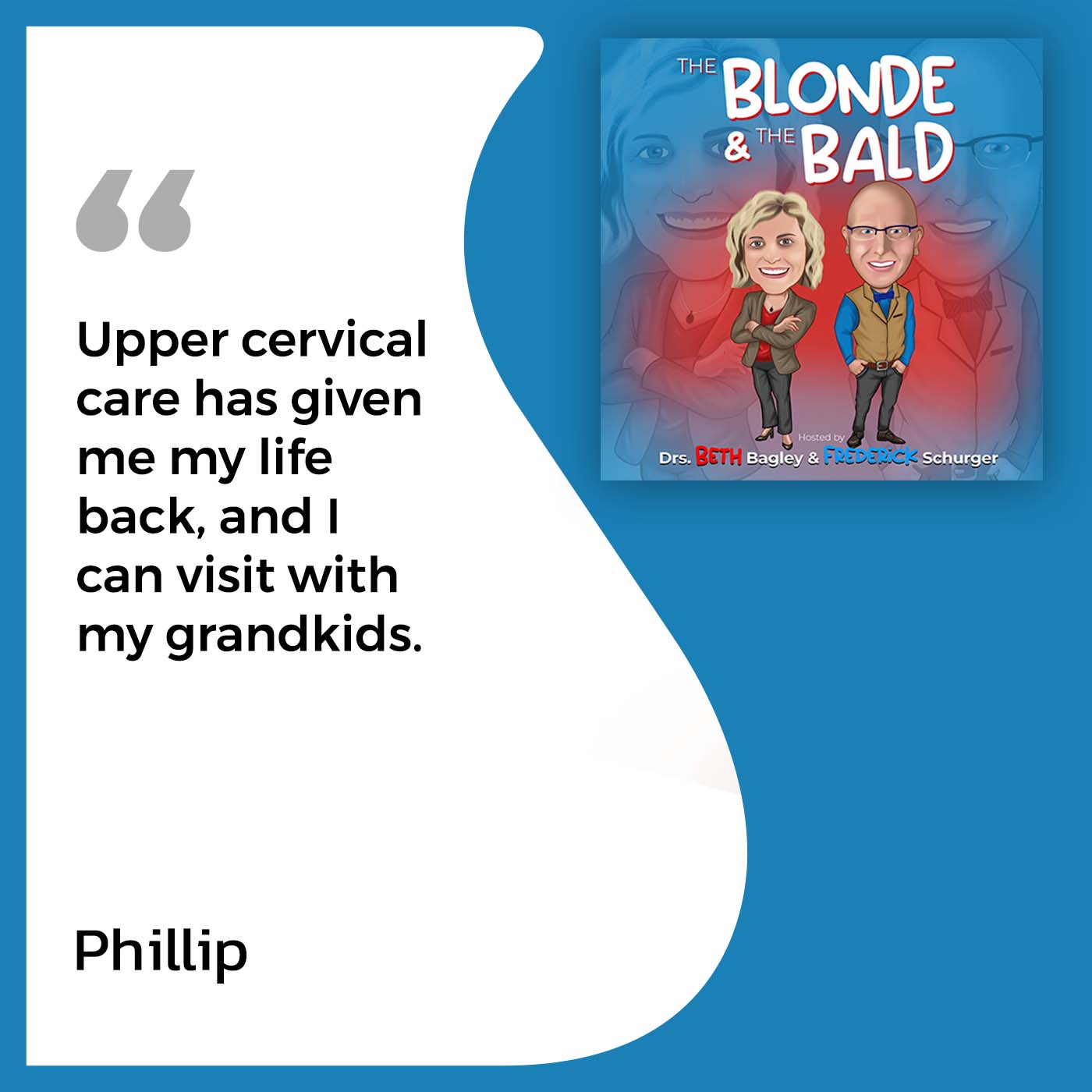
Sometimes you get a little trouble where they roughhouse and he has to come back.
My neck still is vulnerable, on going out.
He is one of the patients that has the most trouble holding an adjustment. One of our goals, as upper chiropractors, is to get people to hold their adjustments and hold them for the long-term. That isn’t the case for you. I want that for you but it doesn’t hold long.
With Dr. Bagley’s care of my quality of life, I would say it is 90%. In the beginning, it was zero. I could not function. I had to sleep sitting up from exhaustion.
I can’t imagine that. How did you function at all, trying to sleep like that?
I had no choice. It was survival. At that time, we didn’t know if it was C1 or C2. Every day, you would think, “Tomorrow, it will be better.” That is how I ran on that for several something days. We have two children. They both live out of town. They even came home because they did not know if I was going to be there.
It was severe and I didn’t even want to think about how awful it was. I can’t jumble for 40-something minutes. I went through the shots of the neck under a live camera. I went to a neurologist. I went to headache care centers. Nothing has helped except the upper cervical care. I went through neck braces. I could keep on going. This is where it is at. This is what saved me.
We hear that commonly, especially with trigeminal cases and some migraine cases. Nothing is touching it. Nothing is getting better. Nothing is getting your quality of life back. We get you adjusted and things start working out better. I do have a question. How often do you need to get adjusted as things are going?
Once or twice a week. When I feel good, sometimes I will overdo it and do something at home that I should not be doing. We have to take that into accountability also.
How worried are you about doing something over the top sometimes, knowing that Dr. Bagley is available?
Knowing she is available, I’m not worried about it at all. If I know the lady is out of town, I behave myself.
That is why I don’t want to tell him I’m in town so he takes better care of himself.
It has been a long struggle since that started. There is a nerve surgeon here in St. Louis. My primary care sent me to him. He also diagnosed the C1 and C2 problems as hitting the trigeminal nerve. He was good because we thought it might be a nerve problem in my head that needed operating on. He said I could use surgery but I chose not to because I’m much better than I was.
Surgery is great as a last resort because everything else is failed. The problem with surgery is the one-directional thing. You do it and there is no undoing it.
Surgery is great as a last resort because everything else has failed. But the problem with surgery is it’s a one-directional thing. You do it, and there’s no undoing it.
If the surgery had not worked, I didn’t want to wake up with a permanent headache, which they said, “It would be possible but highly unlikely.” If it didn’t fix the problem, I could not be treated by chiropractic again. I’m not even contemplating that anymore. That was somewhere in that last several years’ timeframe. I am able to function. Even when my neck is out, there are always special circumstances but it is not as bad as it used to be. I’m getting better slowly. That may be humorous after several years.
One of the things that we’ve done differently is that, since Dr. Horton has retired, he comes up here for care. Sometimes he goes to Dr. Rustici in Kansas City because it is the same amount of distance. It depends. He has other families up in Kansas City. We have gotten his Blair CBCT done. It is a lot more specific to him than what we call an HIO doctor. He did the Palmer stuff, which is still a great technique. It has been updated. That is what Blair is. I’m so glad that you had Dr. Horton in your life and that he was able to get to where you are. I can’t wait to see him over the next couple of years and see how much better you can get because I think you can.
I would like to add for anyone else that is going through this. They might rule it out because of an MRI. The surgeon operates on the nerves in your head. I wish I had known the precise professional name for him. He said, “The laydown MRIs were hiding this C1 and C2 problem.” I had multiple MRIs and CAT scans. It hid the problem. I can’t tell you why. If there is someone out there that thinks this might be their trouble but the MRI shows it is okay, at least get a standup MRI if nothing else and go further.
We agree with that. We talk a lot about upright MRIs.
There is no sense in losing one’s lifestyle or life if one gets depressed enough in such pain when the care is here.
In the Midwest, Dr. Schurger and I are the places to go. If you go to the Blair Chiropractic website, you can find doctors across the country and in the world. There are some across the world, which is cool.
If you go to the Blair Chiropractic website, you can find doctors across countries.
I thank the good lord for my doctors, this lady right here and Dr. Warden.
We will let you get back to your family. Thanks for coming out and I appreciate you telling your story.
Thanks so much, Philip.
Thank you, Doctors.
—
That was a great testimonial by Philip.
He has been through a lot. He is a solid man. He is grateful for the chiropractic care he has gotten with Dr. Horton. If you are out there and are a praying person, say some prayers for Dr. Horton because he is battling cancer. The care he got through him and able to find us up here and thank goodness, he got family up here. There is a reason other than to come to see me come up here and visit his family and somewhere to stay the night when he is up here.
One thing I want to say to anyone out there who has a family member battling trigeminal neuralgia or if you are battling it and are suffering is there is hope out there. Upper cervical care is an answer for many people. You need to find an upper cervical doctor. The Blair website is a great resource but if you can’t find a Blair doctor in your area, know that there are other upper cervical techniques. They have good results too. Do some Google searches. If you find an upper cervical doctor 600 miles from you, call there to the office.
Call our offices. We know the people are.
You might not know how to find them. We would be happy to find those people for you someone to help you close by.
Oftentimes, we have these people on speed dial on our phones because they are close friends. The trigeminal neuralgia was a problem for Philip. He got to get propped up into a corner. I can barely imagine how they put the cushions around him so he can sleep at night because he can’t get comfortable.
My patients joke about it after they get adjusted. I have got these zero-gravity chairs. They make a comment, “Doc, let me stay here all night long. Don’t worry about me. Come in the morning and let me out.” The funny thing is I got one of these zero-gravity chairs. I have fallen asleep in it many a time. It is a nice nap.
What is curious is even after maybe a couple of hours of sleeping in that, if I’m still trying to sleep the night through, I need to go into a bed and lay flat. I don’t know what the biological mechanism is. Probably a sleep expert can explain this. I need to be able to stretch out. I need to lay on my side to let some things, whatever processes my body is trying to relax. As soon as he said it was 44 days that he could not lay in any position, I felt for him. I can’t imagine that. I have had my fair share of my back hurting. Certain positions were no good. That is horrible.
In episode thirteen, we touched on some trigeminal stuff with my sister. She did not have the severity or the length of severity that Philip had because she was much younger and didn’t have much damage. You got some neurology stuff to talk about. That is important if you are going through this, know someone or are interested in science and a science geek, which we love. The neurology of the trigeminal nucleus and the trigeminal nerve coming out of the brain stem is cool. I know a neurology expert and his name is Dr. Schurger.
One of the biggest things that I hear from my trigeminal neuralgia patients from their doctors, not always their neurologist but oftentimes from their doctor, is, “The trigeminal nerve comes out in the head, not in the neck.” Why is the neck having such a profound effect? The problem ended up being what resource they were taught and how much science they taught as far as neurology goes.
When we are studying the spinal cord itself, we are not looking at some of these odd spots. They show us a general shape. They say, “This applies to most of the cord because, for 90%, these things apply.” This is a cross-section of the cord about C5 areas. That is down here. I have been looking at a couple of people’s necks.
If you want to get a good sense of where your C5 or your fifth cervical is, it is about that little crease in your neck. That is about where C5 is. This is what that looks like. It is an actual slice of it. This is much larger. Front to back, we are no more than a centimeter. It is the same with side to side. It is a little bit wider than it is front to back but it is not wide.
It is bigger here and a little bit further down than it is like C3 or T1 because a whole bunch of nerves starts coming out as C5 that go down the arms.
Things go back and forth along the way here. When we come to the actual labels, they say, “These are the parts and the pieces that are involved here.” We come around, “This is the lateral cortical spinal tract.” What I don’t have is a breakout of this low back or they would consider sacral or lumbar and cross here. It doesn’t cut in towards the spinal cord but it goes parallel to this outer surface here.
Low back, lumbar, thoracic, cervical and lateral cortical spinal tract are going to be part and parcel to some of the stuff going on in your lower back, which is where you are going to feel stuff first. That is why we start seeing those effects. This is lower in the spinal cord than the C1 and C2 we are dealing with here. I bought this book for this page. The only reason I bought this book was because it had this slice in color. This is a slice at C1. It looks very different than this.
I didn’t pull up a brainstem picture but it looks more like the brainstem than it does look like the spinal cord. If you are trying to figure out what the difference is between as it changes from the brainstem to the spinal cord, what’s the difference? It is like driving down a road that has one name. You crossed an intersection and it has another name. Up here, we got Jefferson and another part of town is Clear Lake Avenue here in Springfield.
In St. Louis, we have Lindbergh Road. That changes name to Kirkwood Road and back to Lindbergh Road. St. Louis is covered with roads that change names.
It is the same road as you have gone past an imaginary line in St. Louis and up here. Sometimes it was a township line or a city line. Who knows what it is? In our neurology, the difference between the brainstem and spinal cord is an imaginary line that somebody said, “It is outside of the skull. Therefore, it is a spinal cord instead of being brainstem.” It looks the same. When we come down to this next picture, we got that lateral cortical spinal tract that is sitting in here that we were looking at that was sitting more out this way but we have the trigeminal nucleus.
Explain what a nucleus is for somebody who doesn’t know.
A nucleus is your CPU. If you think about your nucleus, for lack of a better way to describe it, the nucleus is interfacing and sending signals back and forth. It is very much like a CPU. We would have multiple little CPUs. Think about a modern computer. It doesn’t have one CPU. Sometimes you got quad-core or 16-core and a video card on top of your processor. We could almost look at every one of these nuclei as an individual processor doing things. In the case of the spinal trigeminal nucleus part portions, which are these pieces right in here, these are pain centers for your trigeminal nerves. This is at C1.
Does it stop there? Does it go further?
It drops down to at least 2 or 3.
Those little shots elongate down.
Here is Atlas. I’m pointing right underneath my ear. It drops down to about C3. If you think about the upper portion that goes up into the brainstem, it is right about the center of your ear. If you were going to put your finger in your ear, don’t put your finger in your ear. We don’t need to do that. If you did, that is the upper part of that spinal trigeminal nucleus. It drops down into the neck. More importantly, the upper part is going to be a lot of sensation. You could almost break them into two parts or processors. One processor is for pain and another processor is for sensation. You got these two pieces. The spinal portion is where the pain ends up being more pronounced.
You can see where this curves around to the outside edge here. You can see almost to a point. This outer edge right about here is where the dentate ligament comes in to help stabilize your spinal cord in the center of the canal. The problem ends up happening when we have shifted the atlas out of place. We have still tethered above in similar spots.
You can imagine you got a spot here and a spot underneath where my thumbs are. This is the atlas. The atlas has twisted. You are exposing and potentially causing pressure on that spinal trigeminal nucleus, which can lead to that whole horrible trigeminal neuralgia in that presentation. Why does an upper cervical adjustment almost always be the thing that clears these people out? It is because that is where the nerve is most pronounced. That is where the pain centers are most turned on.
Do you use my misalignment to show people their misalignments?
I show it a little bit.
The dentate ligaments are in the wrong spot on C1 but it could explain it to somebody if they are looking at it. This is a rudimentary look at the atlas. One of the ways that we explained it to patients is that the atlas shifts and it shifts back to where it is supposed to be with an adjustment, which is what we want. I like this one because it’s showing the shift from above down. We can see how the pulling of those dentate ligaments is. What Dr. Schurger was saying is, “Up here, they come out from the side.”
My criticism of this is, who put this together? It was an artist’s rendition.
In general, if we are teaching a patient this, we can say that there are these little ligaments that hold the spinal cord in the center of this area. It doesn’t bounce around because we don’t want it bouncing around. We don’t want your brainstem bouncing around.
It looks like there are four ligaments holding it in place. There are two at each level. You got one on either side. If my head is the spinal cord, you got one coming out here. You got a set coming out here at the occiput. You have a set coming out here at C1. You have another set coming out here at C2, all horizontal.
At each level, there is another set. They start changing angles.
Instead of being horizontal and tight, trying to keep everything stable at that spot, they start coming out this way because what do we do? We move, flex and extend. We need a little bit of ability for that spinal cord to go back and forth. In this area, it wants to stay fairly straight and stable because what is attached immediately above it? The brain. We don’t want the brain pulling down outside of the skull, which ends up happening, as we find on a lot of those upright MRIs that Philip mentioned.
It was cool that he knew about that. I do not talk to him about that much. That is cool that he has done the research on that. When there is a shift in the upper cervical spine, it is going to pull the dentate ligaments. That is one of the hypotheses of how the upper cervical is effective. There are multiple reasons.
When there’s a shift in the upper cervical spine, it will pull the dentate ligaments. That’s one of the hypotheses of how an upper cervical is so effective.
You have a vascular component to this.
You have cerebral spinal fluid.
You have three different fluids going into the brain, as we have discussed in our previous episodes but you got oxygenated blood and deoxygenated blood. It is your artery flow and venous flow. You also have cerebral spinal fluid. To get to my hand, I have two things. I have the artery flow going in and the venous flow going out. You add a third component to that. This is why the brain and why neuroscience is neuroscience.
You were talking about the lateral corticospinal tracts. It could affect the trigeminal nerve for some people, which is unfortunate and terrible. What affects almost everyone I have seen, if not everyone, is when atlas is out, that lateral corticospinal tract is affected and it causes a shift in how these muscles work. It pulls one leg shorter than the other when someone is lying down. When they are standing, what we end up seeing is one hip will be higher. This person is almost lying down because you can’t stand on a floaty leg. If this person were standing, the left leg would be shorter or touching the ground and down.
If they were lying down, we would see this leg pulling up short. When we do an adjustment, which is within seconds of the adjustment, we can flip someone on their back real quick and see that this has occurred, where their leg lengths are even. That is why somebody who has low back pain can get an upper cervical adjustment turnover and be like, “How did you do that, Doc? Are you magic?” I was like, “No, we are not magic.” We created balance within that brainstem and atlas area. Your back isn’t getting pulled on anymore, which is cool.
I had a young man in his 70s. His wife has been coming to see me forever. She has been coming to see me for several years. She started knowing she was out of adjustment when her foot would hurt. It was the weirdest thing. She was suffering from migraines but her foot would hurt.
That was her warning.
She was like, “I got something going on.” She doesn’t have that problem anymore. Her husband always brings her over because they live over in Decatur, which is about an hour out. He is an engineer. He is one of those guys. I either have the easiest time or the hardest time with my engineers because they would be like, “You got that diploma on your wall. How did you get into this?” We start talking. They were like, “I need to come see you.”
I had another guy who had started. He was like, “My back feels better, Doc. I think you got something going here.” This older gentleman has been in bed for the past several weeks. His wife is beside herself, trying to figure out what to do. He comes over for the drive. Imagine he has been in bed for several weeks and he has been hurting badly. He is finally saying, “I will try it.” His color looks off.
This is a man who built his own house. He is that kind of engineer. He has done all the things. He is not looking like his normal self. All of a sudden, he was like, “Doc, I will try it.” I wasn’t letting him leave my office without getting adjusted. I took the picture. I said, “You guys sit back in my imaging room. I’m going to take care of a couple of people. We are going to figure this out.” 1 in 2 counter rotation. I get them both adjusted and immediately, he stands up. His wife can see that he is standing up straighter. He was like, “This is better.” We have him rest.
I have had to adjust him once more on Wednesday. It was bad. He was in again. I had to do some work on his low back because it has been 30 years that he has been having this problem. He noticed his knee was better. He was like, “I don’t understand how the knee is connected to this.” I’m like, “They are all connected.” What was the analogy that I used for him? I don’t want to use the one analogy. You would love it but I’m not.
It is probably bad. You are going to scare people away with it.
I’m not going to use it but it is a radio station.
That one is not scary.
If you think about a radio station, people are like, “Doc, I don’t know how something up here takes care of something down there because it is so far away.” I respond, “Did the music come out of your radio because it was always on your radio? Where did that radio station come from? How many hundreds of miles away sometimes did that radio station or that signal on your TV come from?”
This was Dr. Palmer’s argument about what it is that we do and how we are connected to a higher energy source, a higher power and God that he called it. For those of you who are young who don’t understand how radio devices used to require you to turn the dial back and forth and tune in, you had to go back and forth a little bit. It wasn’t the 97.3 that you would dial.
You think tuning it might even help you get a better signal.
I can’t get the jazz station coming out of St. Louis or down in Edwardsville up here because of where I’m at. I can’t dial that. Dr. B.J. Palmer, who is our forefront and our developer of the upper cervical work, called it radio station God. If we did not have our atlas on straight, we could not be properly tuned into that source to allow our body and life force to function the way it is supposed to. It is profound. When you see people’s lives go from 0% quality of life to 90% quality of life in no time, that is a miracle.
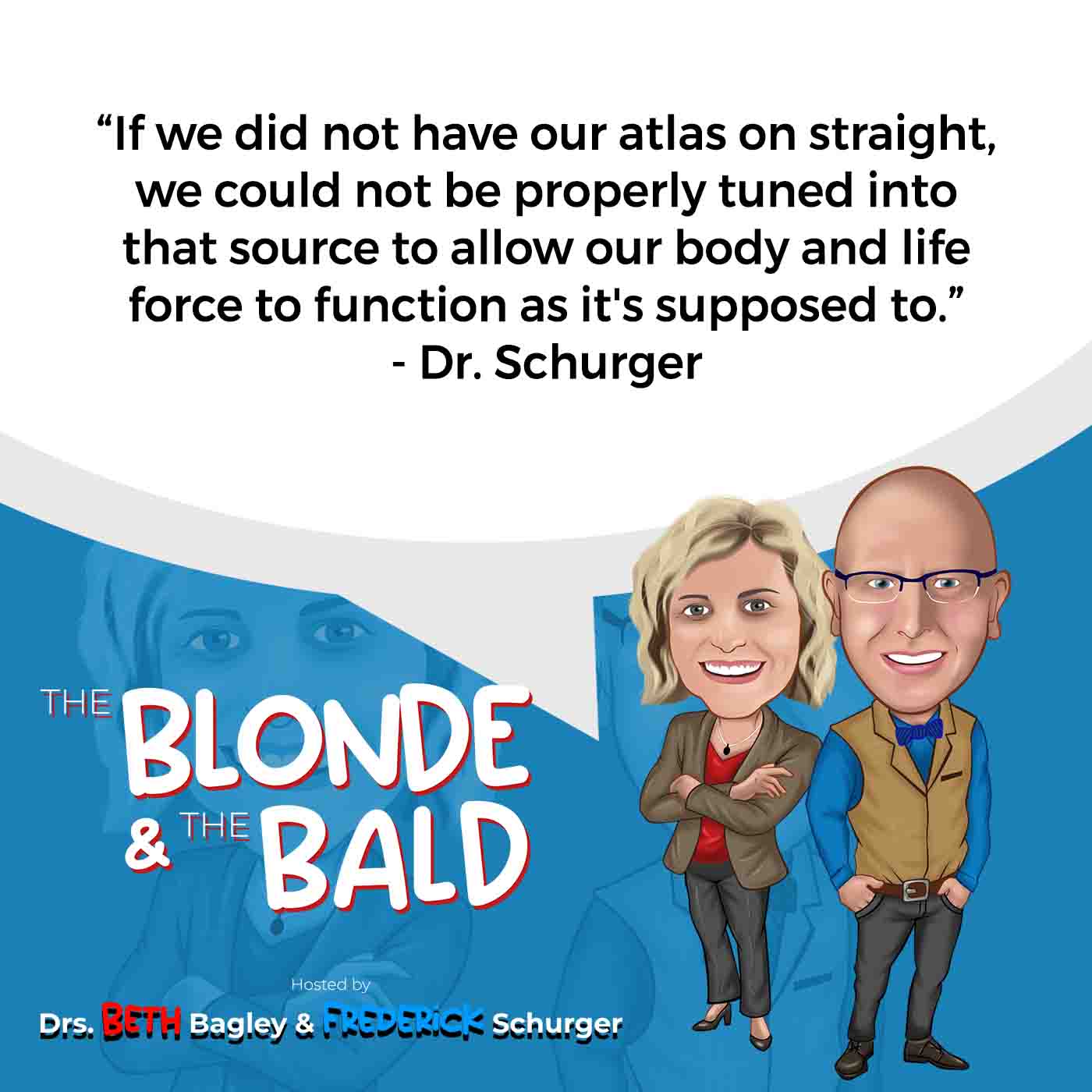
There is this gentleman who started seeing me. He is 80. I don’t honestly know how he found us. One of his kids that lives out of town did internet searching and found us. He was getting driven from North County St. Louis. It was a good 30-minute drive in traffic if it was traffic time. He walked in, hunched over and not healthy looking.
He was very nice. He wasn’t mean or anything but hard to even have a conversation with him. He wasn’t connected. He was an old man. I felt for him. He and his family knew that wasn’t him. That is not how he has been. He has been a hard worker. He worked at McDonnell Douglas. He built things. This is a strong-working guy.
He walked out with a pep in his step. He has been driving short distances. He didn’t drive down to us but he has been driving again. He went and played the Lato. I was like, “Remember the little people when you win.” It was incredible. Is that one of those miracles where the person wasn’t walking when they walked in but he was dizzy, disoriented and wasn’t making sense? His family knew something was wrong. His daughter did some research, got him in here and paid for him to come in, which is sweet. It is a great family. All are taking care of him. This man is changed.
Some people are like, “I am. That is what I’m paying for.” It is funny because I’m like, “This is a miracle. You are a walking miracle. Your body was designed to heal. The interference was keeping it from healing. We are getting you back on track. You are healing again. Your body is doing phenomenally.” I have such appreciation for that and it makes my heart happy. I know it makes your heart happy but we get to see this every day. How lucky are we? Sometimes it is hard to be here because we put so much effort and love into our patients. It is exhausting but is it worth it?
I had a day on Monday. I started at 5:30 because that was the way my brain was starting to function and everyone was calling in. The better part was when you were on point. Mondays are my fasting days. I don’t eat from dinner Sunday night to dinner Monday night. I just go. I was out by 9:00 and it was a great sleep. It is amazing what we can go through and how we can help people. People need to realize that there is something bigger and greater for them. Sometimes getting their head on straight is what is holding them back from being able to achieve those things.
Your life force is being squeezed off. You have vitality in you that is beyond what you can even comprehend. You need to turn the light switch back on and bring the dimmer switch back to where it is supposed to be. That is a good place to end.
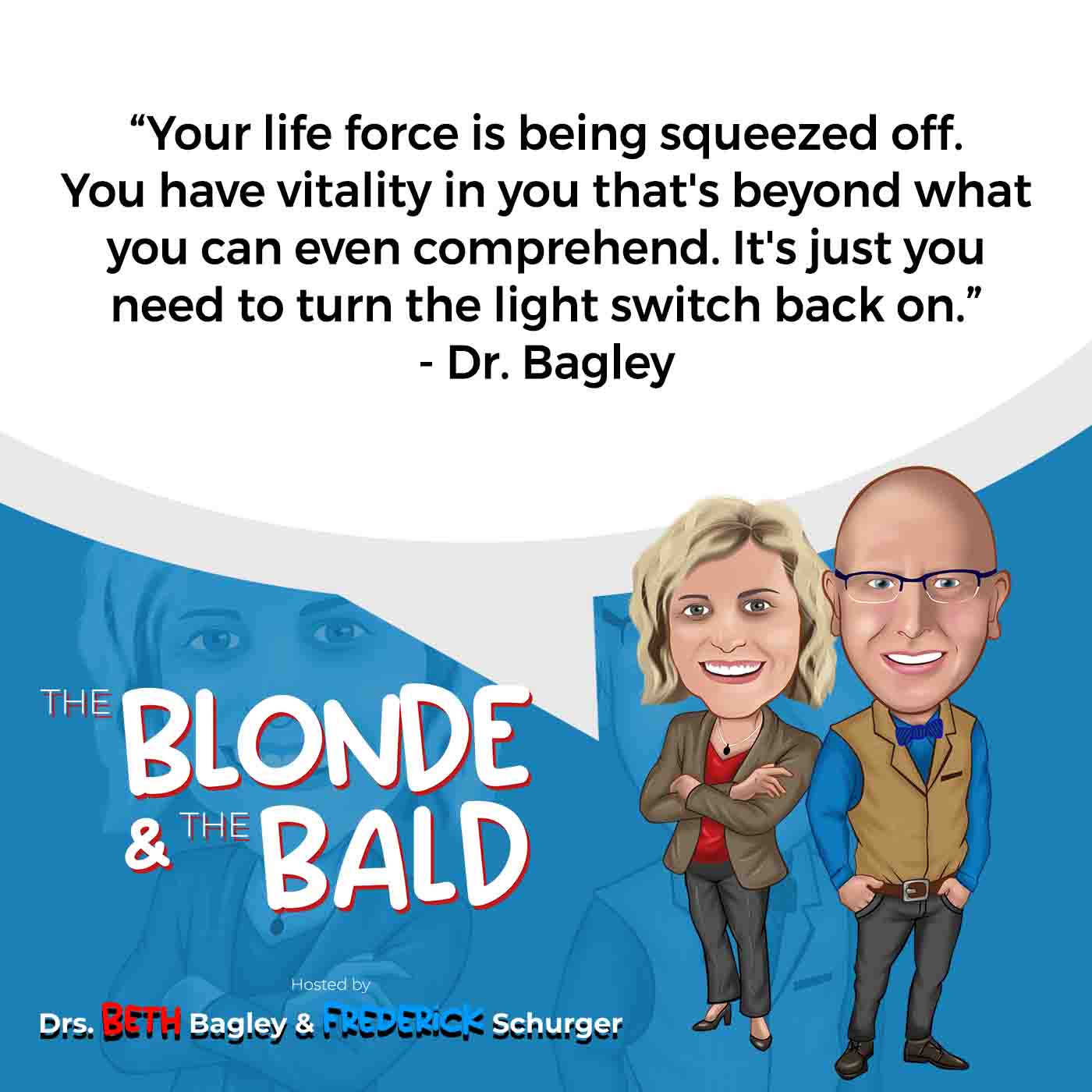
We can’t move up from that. Where are they going to find you?
I am in St. Louis, Missouri. We are on the West Side. We are at PrecisionChiroSTL.com and you can find us on all the socials too. I’m Dr. Beth Bagley.
I’m Dr. Frederick Schurger, Keystone Chiropractic in Springfield, Illinois. We are on a lot of socials. I’m not going to get on TikTok but that’s another story. I do monitor all the socials for the show. If you got some questions and five-star reviews, I would love to have people share this. You don’t have to say a lot. Say, “They are not stupid and boring but make sure you subscribe.” Make sure you are doing reviews and sharing this with your friends and family, especially this episode here. Philip’s story is not uncommon. It is the sad part.
Sometimes, it ends badly. That is what we want to stop. We don’t want these people to suffer anymore.
Make sure you like, subscribe and share. We will be back next episode. You guys all have a great day.
Important Links
- Blair Chiropractic
- Episode Thirteen – Past Episode
- Dr. Beth Bagley – LinkedIn
- Dr. Frederick Schurger – LinkedIn
- https://Linktr.ee/TheBlondeAndTheBald





